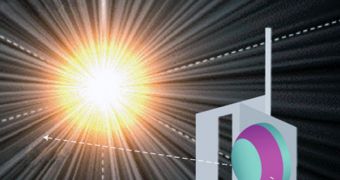Black holes are known to be the remnants of massive stars' collapsed cores, which fall under their own weight to an area of intense gravity that is so large, it can even absorb light. Supermassive ones can be found at the core of all large galaxies, but, even then, they cannot be accurately studied because all sensors that emit radiation at them receive no feedback. After getting used to the fact that there is nothing they can do about this, astronomers have turned to studying the large swirls of matter that any black hole attracts, namely its accretion disk, ScienceNow reports.
Scientists at the Osaka University, in Japan, have recently been able to create an accurate simulation of an accretion disk in the laboratory, blasting a plastic pellet with high-energy laser beams. The physicists say that the achievement could be used to gain more insight into the way matter and energy behave when subjected to the influences of extreme environmental conditions. Undoubtedly, the immediate vicinity of a black hole can be considered to be a generator of extreme conditions.
The gravitational energy that a black hole gives off exerts a very strong influence on the accretion disk, making it glow in X-ray wavelengths. Astronomers still don't know precisely how much energy is needed in order to make these highly energetic radiations. Photoionization, the process through which the high-energy photons that convey X-rays strip electrons from the matter in the accretion disk, is part of the mystery. This step in the emission process makes the total energy of the X-rays more difficult to measure, scientists say.
The Japanese researchers created the new experiment precisely in order to determine how much energy the photoionized atoms consumed. The way they did that was by firing 12 laser beams simultaneously on a tiny, plastic pellet. The high energy of the lasers made the pellet implode into a ball of plasma, and turned it into “a source of [immensely powerful] x-rays similar to those from an accretion disk around a black hole,” Shinsuke Fujioka, a physicist at the university and the lead author of a new study detailing the finds, explains.
The radiations were then allowed to impact a small, silicon pellet, which helped researchers measure the intensity of the blast. “Fujioka et al. have shown us a versatile new way to explore the processes at work near black holes,” University of Michigan physicist R. Paul Drake says. Details of the finds appear in the latest issue of the scientific journal Nature Physics.

 14 DAY TRIAL //
14 DAY TRIAL //